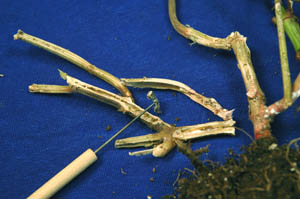What Is White Mold? | |
|---|---|
| August 28, 2007 | |
|
White mold is the common name for a fungal disease that occurs in very wet conditions. Other common names include watery soft rot, cottony rot, and Sclerotinia disease. Heavily irrigated areas may have this problem even when rainfall is short. The disease appears where the planting is dense and the soil is wet. The northern part of Illinois certainly qualifies this year. The causal fungus is Sclerotinia sclerotiorum, S. minor, or S. trifoliorum. These fungi can infect hundreds of plant species. Look for the disease on aster, begonia, columbine, dahlia, delphinium, larkspur, peony, snapdragon, and other garden plants. Vegetables such as bean, carrots, tomatoes, and peas are hosts, as well as soybeans and some woody plants. Symptoms of white mold may occur on any above- or belowground portion of the host plant. You’ll see the problem where plantings are dense and the soil is wet. Look for tan or bleached lesions, especially on the stems, which become covered with a fluffy white mycelial growth (mold). This growth is very white and wispy, as compared to the dense, gray mold of Botrytis. Stem tissue dies from the site of infection to the tip of the stems. As the disease develops, you see large, black resting bodies of the fungus that look much like irregular rabbit pellets. These resting bodies are called sclerotia, and they are composed of tightly packed mycelia. They grow in or on the plant tissue. The image shows a salvia plant infected with white mold. A sclerotium is indicated on the probe.  Although black on the outside, these resting bodies are white inside. As the infected plant tissue dries, the white mycelium may dry up or disappear, but the canker still looks bleached or tan, as if it were grabbed by a very hot hand or glove. This disease is discussed in Report on Plant Disease (RPD), no. 1008, available at http://www.ag.uiuc.edu/%7Evista/horticul.htm, listed as “Sclerotinia Disease, White Mold or Watery Soft Rot,” or find it in Illinois Extension offices. Correct identification of the white mold disease is important to disease control. The resting stage may remain in the soil for many years, causing problems at that location on many other hosts. Sclerotia in the top 2 to 3 inches of soil germinate each year given a favorable environment. There is no cure for infected plants. When replanting, choose nonhost crops for the infected area. A list of plants susceptible to this disease is provided in RPD, no. 1008. |